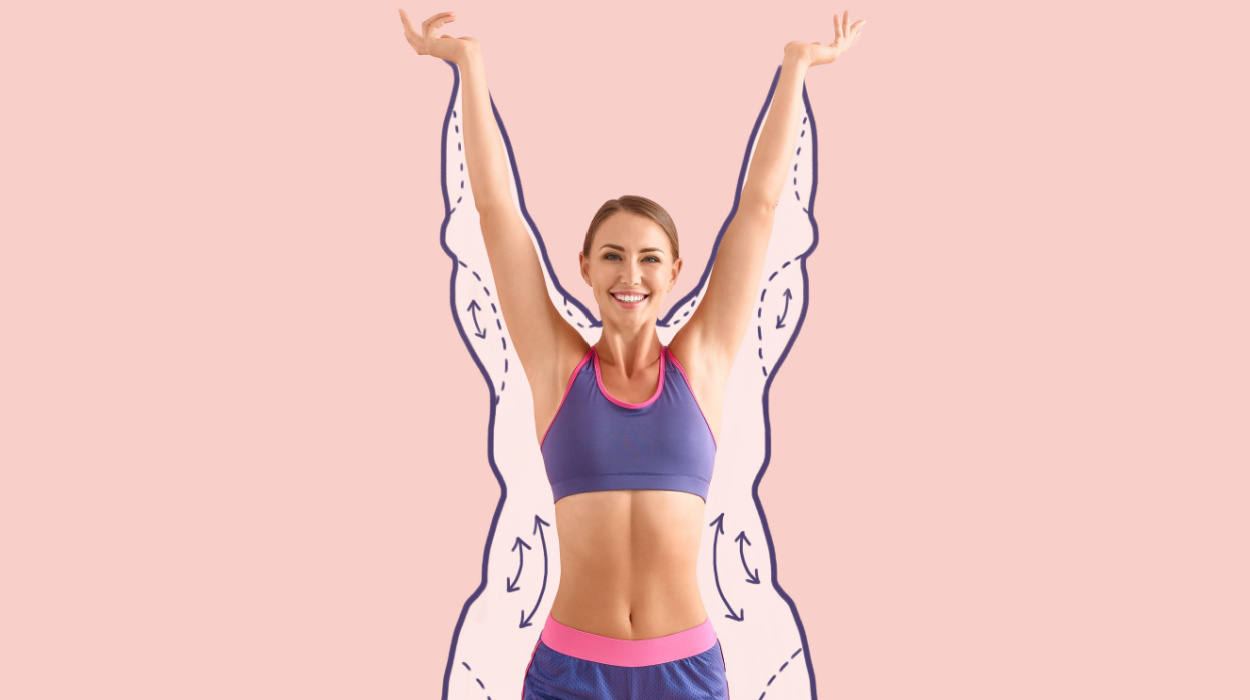You’ve just found yourself scrolling through TikTok, bombarded with endless ways to lose upper body fat. Maybe you’re feeling overwhelmed by the overflow of information. It’s hard not to when you don’t know what’s helpful and what’s just another trendy quick fix. We get it.
In this article, we’re going to explain the best ways to lose fat while focusing on total body health. This means the information given to you will help improve your overall health and well-being. Whether you want to understand the health risks of excess upper body fat or just want to know how to lose upper body fat, this is for you.
What Are The Best Ways To Reduce Upper Body Fat?
Four ways to lose upper body fat include:
- Caloric Deficit: A 500-750 calorie deficit has shown to be effective for weight loss.
- Cardiovascular Exercise: Aim to get at least 150 minutes of moderate-intensity aerobic exercise per week.
- Targeted Upper-Body Workouts: Tone your upper body muscles by engaging in strength training exercise at least twice a week.
- Focusing On Whole Foods: Limiting processed foods can help prevent unwanted weight gain.
4 Ways To Lose Upper Body Fat That Actually Works

There’s no shortage of ways to reduce annoying upper body fat, which means more options for you when creating a weight loss plan. Here are four practical ways to lose upper body weight based on research:
Caloric Deficit
This might be the first thing that comes to mind when you think of ways to lose fat. To be in a calorie deficit, you need to consume less calories than what you’re expending daily. You can also think of this as eating less and moving your body more. This is a great way to reduce upper body fat in both men and women.
A calorie deficit approach may sound easy enough, but you may still be wondering, “But how many calories do you need to cut out for it to be effective?” Multiple studies[1] show consuming 500-750 fewer calories is a great way to lose weight.
Adding in exercise can help you maintain your calorie deficit. You could reach this goal by using a combination of exercise and consuming a balanced diet. Let’s say you generally consume 2,000 calories a day, and you want to reduce it to 1,500 calories per day.
To reach the 500-calorie deficit goal, you could consume 250 calories less for the day, which could be as simple as saying no to that tempting late-night dessert. For the other 250 calories, you can get in some cardio exercises, such as running or hiking. Tailor it to meet your needs, and you can make it fun by switching it up to help you stay motivated to reach your weight loss goal.
Cardiovascular Exercise
Aerobic exercise, also called cardio exercise, is a physical activity that increases your heart and breathing rates. The first thing that probably comes to your mind is running, but it also includes other forms of cardio like cycling, swimming, dancing, hiking and brisk walking.
You might wonder, “Okay, but how much cardio exercise do I need?”. Don’t worry, we got you. The Physical Activity Guidelines for Americans[2] says you should get at least 150 minutes of moderate-intensity aerobic weekly exercise. If you prefer a more intense aerobic activity, you should aim for 75 minutes[3] weekly.
To save you from pulling up your calculator on your cell phone, we’ll break that down into simpler terms. 150 minutes spread out across five days of the week is 30 minutes a day. You can choose different activities each day, which keeps you from getting bored quickly.
If you don’t have 30 minutes to spare, you can break it up throughout your day. For example, you can include short 10-15 minute walks into your daily routine. This could be while you sip your morning cup of coffee or while the sun is setting in your neighborhood.
By sticking to those seemingly small, everyday habits, you can lead a healthier lifestyle and eliminate unwanted arm fat.
Targeted Upper-Body Workouts
Another efficient way to lose upper body fat is by doing targeted upper-body workouts. While you can’t spot-reduce targeted areas of fat, you can help reduce overall body fat while increasing muscle mass.
Strength training is a type of exercise that involves lifting weights or resistance to strengthen your muscles. Remember the Physical Activity Activity Guidelines for cardio we just talked about? They also recommend adults should incorporate two days per week of muscle-strengthening[2] activity. Weight lifting is a great way to tone your muscles and burn calories at the same time.
Need a few ideas for upper body exercises for weight loss? The next time you hit the gym, try one of these exercises for muscle growth: bench press, lateral dumbbell raises, or alternating dumbbell bicep curls. If you don’t have access to a gym or prefer to workout at home, don’t worry. You can do exercises like pushups, tricep dips, and core exercises at home and still lose body fat.
The Less Ingredients, The Better: Focusing On Whole Foods
There’s a common perception that consuming fewer carbs is how to approach your weight loss goals when considering diet changes. You might be surprised to know research[4] has shown people to have effective weight loss by only incorporating a whole-food diet. The people in this study didn’t count calories or change any other daily habits, such as exercise, and still lost weight.
Most of us know we’re supposed to eat healthy, but with so many diet trends on the internet, it can be confusing to know what the best approach is.
An easy starting point is to focus on whole foods. Whole foods contain no preservatives or additives. Try to avoid canned food items, as these tend to have added preservatives in them and contribute to a poor diet.
Finally, don’t forget to ensure adequate fluid intake by avoiding sugary drinks. Also, remember to drink enough water every day.
Here are a few examples of whole foods you can incorporate for a healthy diet:
- Whole grains such as brown rice, quinoa, and rolled oats.
- Fresh fruits such as apples, bananas, oranges, and berries.
- Fresh vegetables such as spinach, broccoli, carrots, and kale.
- Legumes such as black beans, kidney beans, and chickpeas.
- Lean protein sources such as chicken, turkey, and salmon.
- Eggs.
By incorporating a healthy diet that focuses on whole foods, you can keep excess upper body fat at bay while improving your overall health at the same time.
What Causes Upper Body Fat?

Multiple lifestyle factors can cause upper body fat. You already know living a more active lifestyle and incorporating a diet that focuses on whole foods can help you avoid excess weight gain. The same is true for other lifestyle factors like your stress levels and quality of sleep.
There’s nothing worse than waking up feeling just as exhausted as when you went to bed the night before. Unfortunately, that’s not the only downside of poor sleep. Not getting enough sleep[5] is associated with an increased risk of weight gain.
Try implementing a bedtime routine to improve your quality of sleep. This could include a guided meditation or breathwork exercise. Not only will this help with sleep, but it may also help reduce your stress levels. This is a double win because high stress[6] levels are linked to weight gain as well.
The Health Risks Of Having Too Much Upper Body Fat
Now that you know some of the leading causes of upper body fat, we will talk about a few of the associated health risks. Concerning upper body fat, there are two main types: Visceral and subcutaneous. Let’s look at these in more detail:
Subcutaneous Fat
This is the fat you can feel when you pinch your skin, as it’s stored between your skin and the underlying muscle tissue. Subcutaneous fat appears to be associated with less severe health risks than visceral fat. But too much of anything is never good, as too much subcutaneous fat can increase your risk of obesity and type 2 diabetes.
Visceral Fat
Visceral fat, also known as belly fat, covers your internal organs, such as the abdomen, liver, and intestines. Everyone has it, but too much can lead to metabolic syndrome.[7] This refers to a cluster of health conditions that often occur together and increase your risk of cardiovascular disease, which could lead to a heart attack or stroke.
Conclusion
There isn’t just one best way to lose upper body fat. It often involves a combination of lifestyle choices like your diet and exercise routine.
Leading a healthy lifestyle not only limits unwanted upper body fat but also can help protect you against serious and sometimes life-threatening health conditions. Following a plan focusing on whole foods, cardio, implementing a calorie deficit, and including strength training into your weekly routine are all ways to limit upper body fat.
Supplements may be helpful in your weight loss journey, but these should always be used as an addition, not as a replacement for the above solutions we shared. For safety, always make sure to check with your primary healthcare provider before taking any supplements, such as fat burner pills.
With this information, we hope you now have a more comprehensive understanding of upper body fat and the changes you can make daily to lead a healthier, fulfilling lifestyle.
Frequently Asked Questions
A few common causes include an unhealthy diet, being sedentary, and not sleeping well.
A common weight loss goal for men is to lose chest fat. Several studies, such as this one,[8] have proven spot reduction ineffective at reducing body fat in a single area.
One pound per week is a realistic and attainable goal when it comes to weight loss.
Cycling[9] is a form of cardio or aerobic exercise that has been shown to be helpful in weight loss efforts.
 Expert's opinion
Expert's opinion